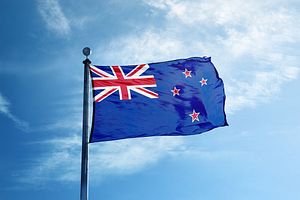Last week the year-long campaign to potentially change New Zealand’s flag came to its conclusion: a decision to keep the existing flag. With the government keen for as much public consultation as possible, the process was conducted in four stages. First, there was a call for public submissions for a new design. Over 10,000 designs were submitted, predictably ranging from the ridiculous to the plausible.
These were then whittled down to what were considered the five most appropriate contenders. Four of the five designs featured a silver fern, a plant indigenous to the islands and of major importance within the native Maori culture. A fifth design, known as the Red Peak, was inspired by the South Island’s mountainous landscape, as well as a color scheme that evoked the Maori mythological creation story. This flag was originally culled from a longlist of 40, but was added to the ballot after a vocal last minute social media campaign.
The acknowledgement of the indigenous population of the islands was a prominent and important feature of the design process.
A referendum was held between November 20 and December 11 of last year to decide which of these five flags would be put up to a second referendum against the existing flag.
The current New Zealand flag was adopted as a de facto national symbol in 1902, when the beginnings of national identity took shape during the Boer War. At the time New Zealand residents had obtained “responsible government” status within the British Empire, and were then to receive semi-independent Dominion status in 1907.
While the flag was flown unofficially during the World War I, it wasn’t used in an official capacity by the New Zealand government until World War II. Both World Wars were instrumental in forging a more independent identity for New Zealand from the British Empire, coinciding with, but also independent of, that of Australia.
Yet for the past few decades there has been an underlying debate in former British colonies about the presence of the Union Jack on their flags, the implication being that the symbol’s presence is, at best, backwards, and at worst, greatly offensive to indigenous populations.
However, most nations rely on symbols of the past, frequently involving wars, for their emotional weight. This is both an argument for and against maintaining New Zealand’s current flag (depending on who you ask).
But with the increasing multiculturalism of countries such as New Zealand and Australia, and greater recognition of the colonial injustices to indigenous populations, acknowledgement of a previous status within the British Empire has become less sustainable.
Canada changed its flag to the Maple Leaf (l’Unifolié in French) in 1965. Of course, with a large Francophone minority (with growing separatist sentiments) the impetus to do so was more pressing.
Due to the close and often symbiotic relationship between New Zealand and Australia this process to change the flag has been closely followed across the Tasman Sea. In Australia, there is also an active campaign to change the flag.
Australians of a progressive persuasion often claim to be embarrassed as New Zealand has legalized gay marriage, further recognized indigenous populations, and pursued an official government-led movement to change their flag. Further, to have these ideas championed by a conservative government is seen as further indication of Australia’s tardiness.
However, this is merely the logistics of democracy. Smaller countries are able to have large, potentially emotional, conversations in both a more direct and restrained manner. The resistance to new ideas can be absorbed, information silos can be penetrated, and persuasive arguments can rise above the noise. The lessons learned from these democratic experiments are then able to filter up to larger countries.
The winning design from the first referendum was a flag with a silver fern on a blue and black background, maintaining the red stars of the Southern Cross Constellation from the existing flag.
However, last week, in the subsequent second referendum to decide whether the flag would in fact be changed, this design was defeated, with 56 percent of voters opting to keep the current flag.
While complaints have been made about the NZ$26 million (US$17.4 million) cost of proceedings that maintained the status quo, New Zealand is to be commended for confronting these issues of national identity in a mature and peaceful manner.
While the process can be praised for being an open and consultative one, with an array of public opinion about which design was the best and why, it won’t actually be known whether the flag was rejected on grounds of design, or a desire to preserve the existing flag.
Either way, the year-long exhibition of ideas concerning national symbols, evolving identity, the country’s past and its future, was a positive, educational, and worthwhile democratic initiative for the people of New Zealand.

































